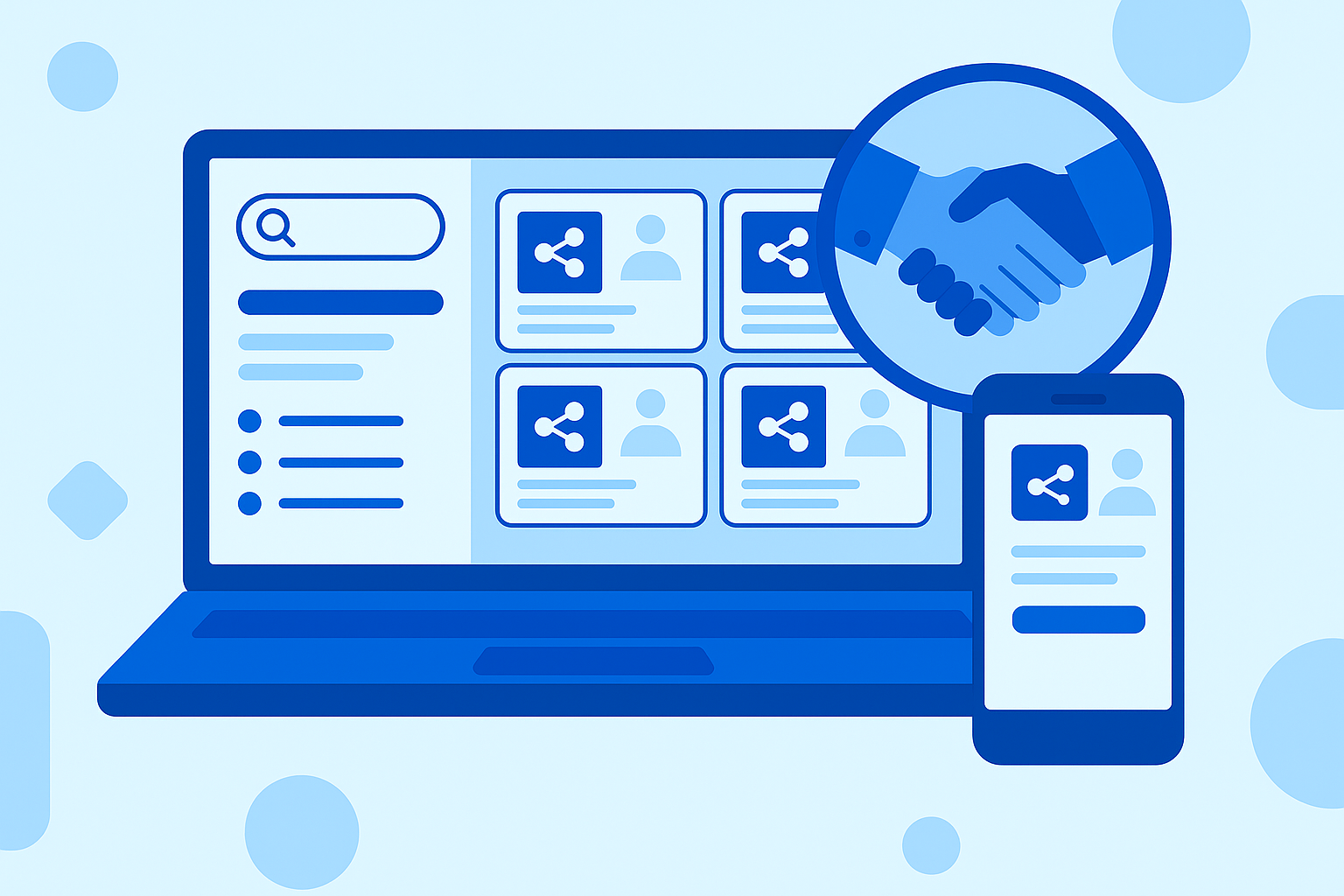A partner marketplace is the new standard for SaaS companies that want to scale their ecosystem, increase conversions, and help customers unlock more value from their product.
If the 2010s were about collecting partners, the 2020s are about activating them. A basic directory on your website can list partners, but it cannot help customers discover solutions, drive adoption, or convert ecosystem demand into revenue. That requires something more modern and dynamic.
Enter the partner marketplace.
A partner marketplace lives both on your website and inside your product. It’s interactive, searchable, and conversion-focused. Customers can browse partners, explore integrations, see services, understand value, and take action. It behaves like a real product experience rather than a brochure page, and it becomes one of the highest-intent properties in your entire funnel.
TL;DR: A partner marketplace is a dynamic hub on your website and inside your app where users discover your ecosystem across tech integrations, service partners, implementation specialists, co-marketing partners, and more. It is interactive, content-rich, purpose-built for conversion, and often powered by AI to streamline content, categorization, and partner collaboration.
A great partner marketplace includes:
✅ Fast search, dynamic filters, and clear partner types
✅ AI-powered listings, categorization, and translations
✅ Embedded in-app for discovery at the exact moment of need
✅ Collaborative tools for partners to manage their own listings
✅ Content-rich partner pages with CTAs that actually convert
Done right, a partner marketplace becomes a growth channel, not a static list.
What is a partner marketplace?
A partner marketplace is an ecosystem experience on your website and in your product that showcases all of your partners across technology, services, solutions, and co-marketing initiatives. It lets customers understand who you work with, how to connect with them, and what problems they can solve.
Instead of a static directory, this is a conversion layer. Users can evaluate partners, view integration details, watch videos, browse case studies, understand value, and click directly into the next step. The result is higher engagement, more installs, and clearer paths to customer success.
Why do SaaS companies need a partner marketplace?
Because customers buy ecosystems, not standalone products. They want to know:
- Who integrates with you
- Who can help them implement your product
- Which partners you trust
- What solutions solve problems you do not solve alone
A partner marketplace makes that information discoverable. It gives your ecosystem visibility across your homepage, marketing site, and inside your actual product. This drives massive improvements in adoption, expansion, and retention.
Without one, your partners and integrations disappear into scattered pages or disjointed spreadsheets. With one, your ecosystem becomes part of your value proposition.
A partner marketplace also gives your internal teams a shared source of truth. Sales can show prospects relevant partners. CS can recommend integration solutions. Marketing can use partner pages to improve SEO. Partnerships can showcase momentum and attract new builders.
What should a partner marketplace include?
A partner marketplace needs to both inform and convert. These are the essentials.
1. Great UX and navigation
- Clear partner types such as Technology, Services, and Solutions
- Filters for industry, category, integration depth, or geography
- Fast, predictive search
- Consistent branding that feels native to your site and product
- A clean mobile experience
Your ecosystem should feel polished, credible, and instantly useful.
2. Modern, high-quality design
A marketplace should look like a real product surface, not a static CMS page. This includes:
- Co-branded images
- Organized grids or cards
- Meaningful visuals like integration badges
- Smart whitespace
- Consistent design tokens
Customers shouldn’t wonder whether your ecosystem is an afterthought.
3. SEO and discoverability
Each partner listing should be structured so it can rank:
- Unique copy, not partner-submitted blurbs
- Meta data and structured data
- Internal linking to related use cases or industry pages
- Schema markup for rich results
A strong marketplace can become a high-performing SEO channel for you and your partners.
4. Collaboration and co-marketing
Your marketplace should make it easy for partners to participate:
- Partners can update and maintain their listings
- Upload screenshots, videos, and case studies
- Submit new partnership requests
- Add co-marketing assets
When partners contribute, the whole ecosystem stays fresh.
5. AI-powered content
Modern marketplaces use AI to improve quality and reduce admin:
- AI listing builders to create content fast
- Automatic tagging and categorization
- AI-driven translations for global teams
- Automated visuals or summaries
This saves time and increases consistency across hundreds of partners.
What belongs on each partner page?
A partner page inside a marketplace is meant to convert. Include:
- Visual hero or banner connecting both brands
- Overview of what the partner does
- Details of integrations, services, or solutions
- Screenshots, demo videos, GIFs, or diagrams
- Testimonials or proven outcomes
- Clear CTAs
- At least a few hundred words of original, SEO-friendly content
The best partner pages act like mini landing pages co-owned by your partner and your brand. They help customers feel confident and take next steps.
Real-world examples
Here are examples of partner marketplaces that show what’s possible:
SmartRecruiters Marketplace
Built with Partner Fleet. Includes both Technology and Service Partners, dynamic filtering, clean design, and rich partner pages.
Healthie’s The Harbor
A blended marketplace for integrations, service partners, and ecosystem solutions. Beautiful, modern, and product-like.
Jasper Partner Marketplace
SEO-friendly, structured, and visually rich. Built to support both customers and partners.
These are all examples of marketplaces built around clear UX, strong visuals, and conversion-focused design.
The takeaway
Your ecosystem deserves more than a hidden list. A partner marketplace makes your partners discoverable, your integrations understandable, and your product undeniably more valuable.
Customers get better solutions. Partners get increased visibility. Your team gets higher conversions. Everyone wins.
If you’re still relying on static pages or spreadsheets, it’s time to elevate your ecosystem. Partner Fleet helps companies launch a modern partner marketplace in weeks, not months.
Book a demo to see how you can launch yours quickly.




